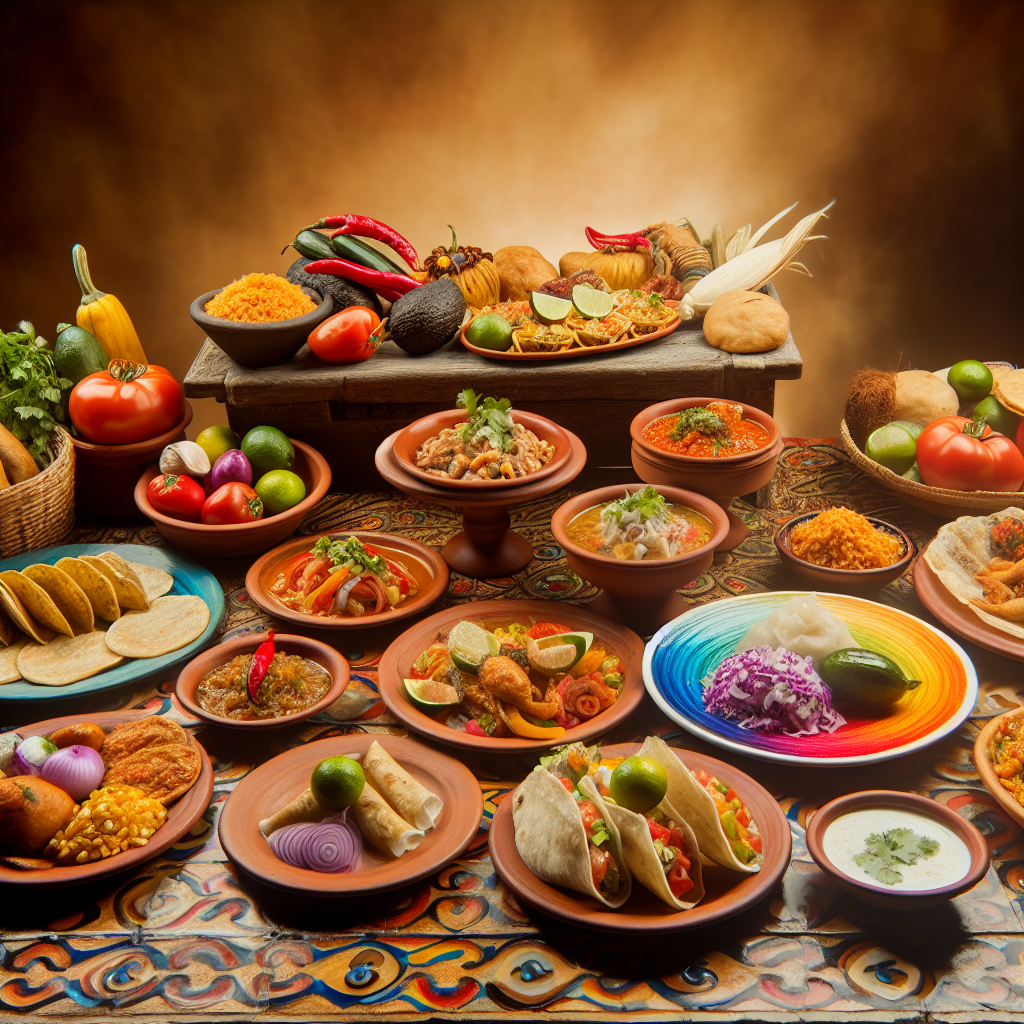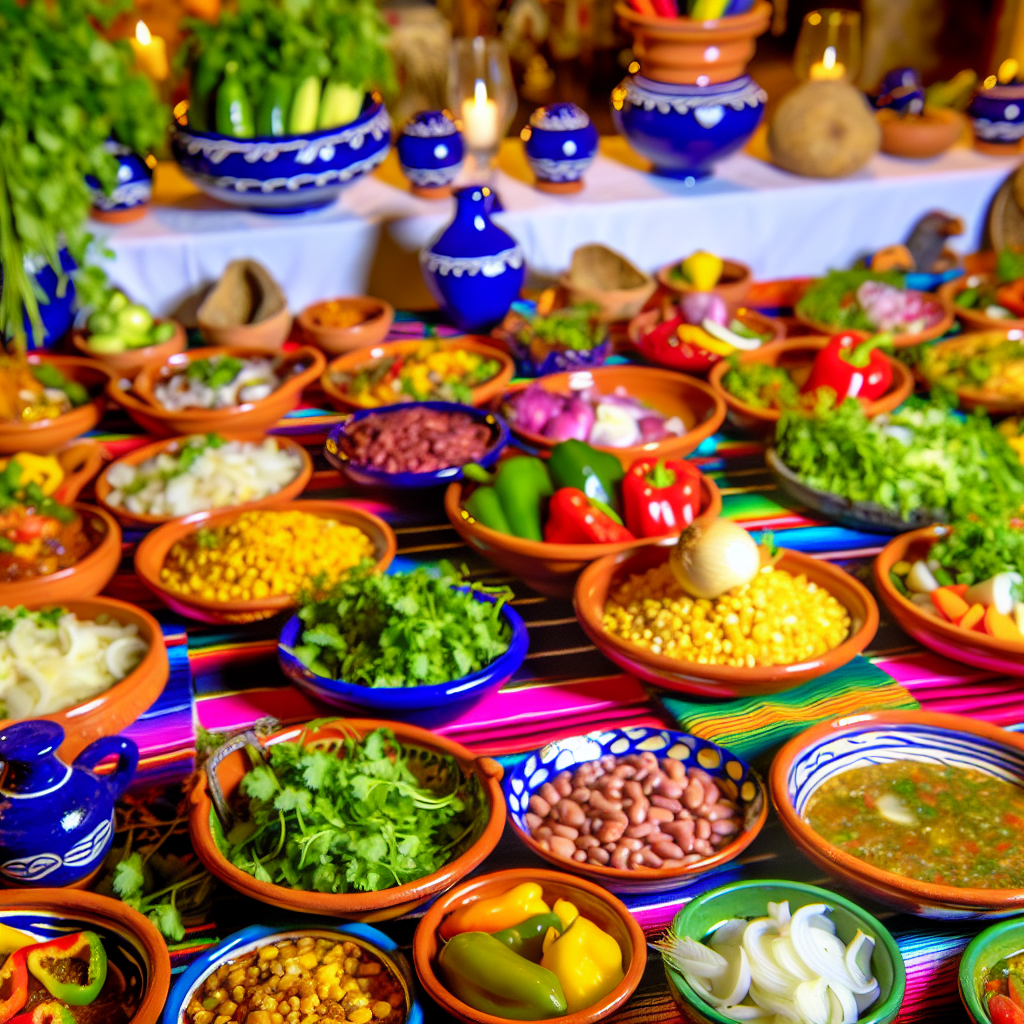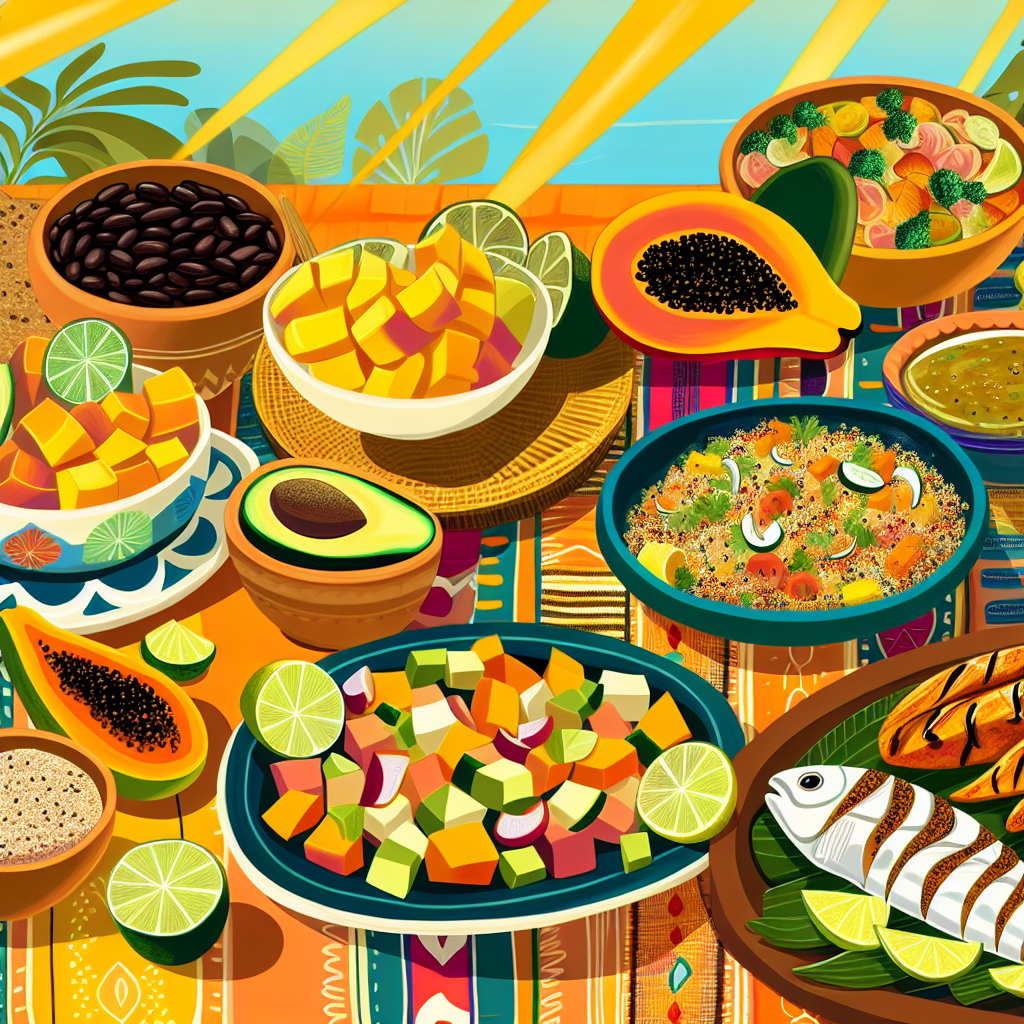Introduction
Latino cuisine offers a rich mix of flavors, traditions, and cultural importance loved by many around the world. As more people become aware of their health, adapting these treasured recipes into a balanced diet is essential. Although Latino food is known for its hearty ingredients, customizing these dishes can lead to healthier eating habits without losing taste or authenticity. This article aims to examine how to adapt Latino cuisine, providing helpful tips and tasty recipes for those eager to eat better while honoring their cultural food traditions. Whether you wish to improve your nutrition or enjoy the bold flavors of Latino cuisine in a healthier manner, this guide will support you on that path with care and understanding.
Benefits of a Balanced Diet for Latino Cuisine
- Nutritional Diversity: Latino cuisine incorporates a wide variety of ingredients, including fruits, vegetables, grains, and proteins, providing a broad spectrum of vitamins and minerals essential for health.
- Cultural Connectivity: Preparing balanced meals allows individuals to connect with their cultural roots while making healthy choices, preserving traditional recipes with healthier adaptations.
- Weight Management: A balanced diet can aid in maintaining a healthy weight, which is particularly important for reducing the risk of chronic diseases prevalent in some Latino communities.
- Heart Health: Many traditional Latino dishes, when made with whole grains and healthy fats, can contribute to heart health, reducing sodium and processed ingredients for better heart function.
- Digestive Health: The inclusion of fiber-rich foods, such as beans and whole grains typical in Latino diets, promotes digestive health and can prevent gastrointestinal issues.
- Enhanced Energy Levels: A balanced intake of carbohydrates, proteins, and healthy fats from Latino foods can sustain energy levels throughout the day, enhancing physical and mental well-being.
- Reduced Risk of Chronic Diseases: By emphasizing whole foods, a balanced diet can lower the risk of conditions such as diabetes and hypertension, which can disproportionately affect Latino populations.
- Family and Community Bonding: Sharing healthy meals based on traditional recipes fosters family connections and communal relationships, emphasizing the importance of food in Latino culture.


Traditional Latino Ingredients
Traditional Latino ingredients are not only celebrated for their flavorful profiles but also for their impressive nutritional benefits. Incorporating these ingredients into a balanced diet can enhance both health and taste.
-
Beans
Beans, including black, pinto, and kidney varieties, are rich in plant-based proteins and dietary fiber. They promote healthy digestion, help in stabilizing blood sugar levels, and contribute to a feeling of fullness, making them a valuable addition to meals such as soups, stews, and salads. These can be integrated into dishes alongside whole grains for complete proteins. -
Whole Grains: Corn and Quinoa
Corn is a staple in the form of tortillas and tamales, providing complex carbohydrates and dietary fiber. Quinoa, known for being a complete protein, offers all nine essential amino acids and is gluten-free. Both grains serve as nutritious bases for various traditional dishes, making them suitable for healthy eating. -
Avocados
Rich in monounsaturated fats, avocados support heart health by lowering bad cholesterol. They also provide essential vitamins and minerals, adding creaminess to salads, smoothies, and salsas while promoting overall health. -
Vegetables: Tomatoes, Peppers, and Squash
Essential for salsas and many traditional dishes, tomatoes and peppers are high in vitamins C and A, while squash varieties provide valuable fiber and nutrients. Integrating these vegetables into side dishes or main courses can enhance nutrient intake significantly. -
Herbs and Spices: Cilantro and Cumin
Cilantro and cumin are not only flavorful but also offer health benefits. Cilantro may have antibacterial properties, and cumin is known for its antioxidant content. These can reduce the need for excess salt and fats while adding depth to dishes.
By utilizing these ingredients, individuals can prepare dishes that honor their cultural roots while also being mindful of their dietary needs. Traditional Latino ingredients can be creatively used in various recipes, ensuring nutrients are part of everyday meals without compromising the vibrant flavors that define Latino cuisine.
Nutritional Benefits of Popular Latino Foods
Latino cuisine is not just celebrated for its vibrant flavors but also for its significant contributions to a balanced diet. Here are some of the key nutritional benefits associated with popular Latino foods:
-
Cazuela Stew
Cazuela is a hearty stew filled with lentils or beans, assorted vegetables, and lean meat. This dish is rich in vitamins, minerals, and dietary fiber, supporting overall health and facilitating digestion. -
Sancocho
This slow-cooked stew includes root vegetables, lean meats, and herbs, offering a nutrient-dense profile. Its anti-inflammatory properties can stabilize blood sugar levels, enhance gut health, and boost immune function. -
Quinoa Dishes
Quinoa is a complete protein, containing all nine essential amino acids, along with fiber. It aids in digestion and contributes to feelings of fullness, making it an excellent base for various traditional dishes. -
Avocado Meals
Rich in monounsaturated fats, avocados help lower bad cholesterol and are packed with potassium, fiber, and multiple vitamins. This fruit adds a creamy texture and enhances the nutritional profile of salads and salsas. -
Ceviche
Ceviche features fresh fish marinated in citrus juices. It provides high-quality lean protein and omega-3 fatty acids, which are known for their anti-inflammatory benefits, supporting heart and brain health. -
Mole Sauce
Mole is a complex sauce made with cacao and various spices. Its rich antioxidant content helps protect cells from damage and contributes to a healthy immune response. -
Vegetable Tamales
Steamed corn dough parcels filled with vegetables provide complex carbohydrates, fiber, vitamins, and minerals. They offer a nutritious, flavorful option in traditional cuisine. -
Beans
Beans are a cornerstone of Latino diets, serving as a great source of plant protein and dietary fiber. They help stabilize blood sugar levels and promote digestive health, supporting weight management and overall wellness.
Incorporating these traditional Latino foods into a diet not only enhances flavor but also ensures a rich intake of essential nutrients that foster a holistic approach to eating healthy. These foods embody the essence of a balanced diet, aligning taste with nutritional integrity, making them a perfect choice for health-conscious individuals.
Common Latino Dishes and Their Nutritional Values
| Dish | Key Ingredients | Calories | Protein (g) | Carbohydrates (g) | Fats (g) | Health Optimization |
|---|---|---|---|---|---|---|
| Cazuela | Lentils, vegetables, lean meats | 350 | 20 | 45 | 10 | Add more fiber-rich vegetables to increase nutrients. |
| Sancocho | Root vegetables, lean meat, herbs | 400 | 25 | 55 | 15 | Stir in dark leafy greens for added vitamins. |
| Quinoa Dishes | Quinoa, vegetables, spices | 220 | 8 | 40 | 4 | Combine with beans for complete protein. |
| Ceviche | Fresh fish, citrus juices, vegetables | 200 | 18 | 5 | 8 | Use more veggies for increased fiber and nutrient intake. |
| Mole Sauce | Cacao, spices, chilies | 150 | 4 | 20 | 6 | Use unsweetened cacao and fresh ingredients to enhance health benefits. |
| Vegetable Tamales | Corn dough, assorted vegetables | 300 | 6 | 60 | 5 | Opt for whole grain masa and more veggies. |
Optimizing Latino Dishes for a Balanced Diet
- Incorporate More Fruits and Vegetables: Enhances vitamins, minerals, and fiber in meals.
- Choose Lean Proteins: Reduces saturated fat by opting for chicken, turkey, or fish.
- Switch to Whole Grains: Boosts fiber content using brown rice and whole grain tortillas.
- Modify Cooking Methods: Favor grilling, baking, or steaming instead of frying.
- Limit High-Fat Dairy: Use reduced-fat cheeses and creams.
- Season Healthily: Enhance flavors with fresh herbs and spices rather than extra salt.
By understanding the nutritional values of these common Latino dishes and knowing how to optimize them, you can continue to enjoy the rich flavors while maintaining a balanced and healthy diet.
Personal Anecdotes from Families About Their Latino Diets
Adapting traditional Latino cuisine to healthier eating habits is a journey deeply intertwined with cultural identity and emotional connections. Families often find innovative ways to honor their heritage while embracing nutritious choices.
For instance, a Colombian parent emphasized the importance of maintaining cultural traditions through diet:
“I feel like my culture plays a role in what I buy to eat. For example, in Colombia we eat lots of vegetables and hearty soups, and I try to keep that as part of our family traditions.”
This sentiment reflects a broader trend where Latino families incorporate more fruits and vegetables into traditional dishes, enhancing their nutritional value without sacrificing flavor. By adding colorful produce like bell peppers, tomatoes, corn, and avocados to meals such as tacos, families boost vitamins, minerals, and fiber intake.
The role of Latina mothers is particularly significant in this adaptation process. Many preserve traditional dietary patterns after immigrating to the United States, incorporating fresh produce into meals, thus positively influencing their children’s eating habits. This approach not only maintains cultural ties but also promotes healthier lifestyles within the family.
However, challenges arise when traditional food rituals change post-migration. Hispanic women have reported alterations in food procurement, preparation, and presentation, which can impact healthful eating. Recognizing and adapting these rituals can serve as leverage points for interventions designed to promote healthy eating behaviors.
Overall, the adaptation of Latino cuisine for healthier eating is a dynamic process that balances cultural preservation with nutritional improvements, fostering both physical well-being and emotional fulfillment.
Here are several examples of Latino families successfully adjusting their diets for health reasons:
-
La Cultura Cura: How Latinos Are Reclaiming Their Ancestral Diets
After being diagnosed with breast cancer, Luz Calvo and Catriona Rueda Esquivel explored cancer-fighting foods and discovered that traditional Mesoamerican diets rich in cactus, squash, corn, wild greens, nuts, and seeds offered protective benefits. This led them to adopt and promote a plant-based diet rooted in their ancestral heritage. (Folklife Magazine) -
For Latino immigrants, good health hard to maintain
Eugenia Delgado, a Mexican immigrant in Minnesota, gained 70 pounds after moving to the U.S. and was diagnosed with gestational diabetes. Concerned about her health and her children’s, she modified her family’s diet by reducing fried foods and incorporating more steamed vegetables and homemade meals, leading to weight loss and improved health. (USC Center for Health Journalism) -
Why some Latinos are (re)turning to plant-based diets
Many Latinos are embracing plant-based diets to reconnect with their precolonial heritage and improve health. This trend is evident in restaurants offering vegan versions of traditional dishes and cookbooks like “Decolonize Your Diet,” which provide plant-based Mexican-American recipes for health and healing. (Novant Health | Healthy Headlines) -
Latino families learn to eat healthy at Wilmington event
At a Wilmington event, nutrition specialist Guadalupe Castañeda demonstrated how Latino families can preserve culinary traditions while making healthier choices. She prepared a plant-based burrito with beans, grated carrots, onion, garlic, mozzarella cheese, lettuce, and a flour tortilla, showcasing that healthy eating can be flavorful, budget-friendly, and culturally relevant. (WHYY)
These anecdotes highlight the adaptability and resilience of Latino families as they navigate the challenges of health and nutrition while honoring their cultural heritage.
Personal Anecdotes from Families About Their Latino Diets
Adapting traditional Latino cuisine to healthier eating habits is a journey that speaks to the heart of cultural identity and emotional connections. Families navigate this landscape with creativity, honoring their roots while making choices that prioritize health for future generations.
For instance, Maria, a mother from Mexico, shared her experience with her children’s eating habits. She recalls,
“Every Sunday, we used to gather for family dinner, where my abuela would prepare her famous mole. But after my daughter’s pediatrician suggested we focus more on vegetables, I felt torn. I didn’t want to lose the tradition, but I knew I had to change. One day, I decided to surprise them. I made a version of mole using avocado instead of oil and added a variety of colorful peppers. The smiles on their faces when they tasted it reminded me that tradition is not just about the recipes; it’s about love and togetherness.”
Maria’s experience illustrates a broader trend among Latino families where they incorporate more fruits and vegetables into cherished dishes. Through her story, readers sense her journey’s emotional weight and the joy of preserving her family’s culinary legacy while adapting to healthier practices.
The impactful role of Latina mothers often emerges in these narratives. Many express their determination to maintain their traditional dietary patterns upon immigrating. Juanita, a young immigrant who embraced the challenges of cooking in a new country, recounted,
“When I moved to the U.S., I missed my abuela’s kitchen—a place filled with the aromas of fresh tamales and beans. It was hard to find those ingredients, but every spice I could get my hands on felt like a connection to home. I started making tamales with whole wheat masa, and I could see my kids excited about eating healthier versions of the foods I loved. Their laughter reminded me of the moments I shared with my family back home; it made the effort worthwhile.”
Juanita’s heartfelt recollection emphasizes the resilience of families as they navigate their identities through food.
However, challenges often loom as traditional food rituals shift after migration. Hispanic women, as reported, encounter significant alterations in how they procure, prepare, and present their traditional dishes. For many, this transition can feel like a loss of connection with their heritage, which is pivotal for family bonding. Recognizing and adapting these rituals can serve as meaningful points for promoting healthy eating behaviors.
Overall, the adaptation of Latino cuisine for healthier eating is a dynamic process that balances cultural preservation with nutritional improvements, fostering not only physical well-being but emotional fulfillment—tying together generations through the love of food, health, and heritage.
Here are several examples of Latino families successfully adjusting their diets for health reasons:
-
La Cultura Cura: How Latinos Are Reclaiming Their Ancestral Diets
After being diagnosed with breast cancer, Luz Calvo and Catriona Rueda Esquivel explored cancer-fighting foods and discovered that traditional Mesoamerican diets rich in cactus, squash, corn, wild greens, nuts, and seeds offered protective benefits. This led them to adopt and promote a plant-based diet rooted in their ancestral heritage. (Folklife Magazine) -
For Latino immigrants, good health hard to maintain
Eugenia Delgado, a Mexican immigrant in Minnesota, gained 70 pounds after moving to the U.S. and was diagnosed with gestational diabetes. Concerned about her health and her children’s, she modified her family’s diet by reducing fried foods and incorporating more steamed vegetables and homemade meals, leading to weight loss and improved health. (USC Center for Health Journalism) -
Why some Latinos are (re)turning to plant-based diets
Many Latinos are embracing plant-based diets to reconnect with their precolonial heritage and improve health. This trend is evident in restaurants offering vegan versions of traditional dishes and cookbooks like “Decolonize Your Diet,” which provide plant-based Mexican-American recipes for health and healing. (Novant Health | Healthy Headlines) -
Latino families learn to eat healthy at Wilmington event
At a Wilmington event, nutrition specialist Guadalupe Castañeda demonstrated how Latino families can preserve culinary traditions while making healthier choices. She prepared a plant-based burrito with beans, grated carrots, onion, garlic, mozzarella cheese, lettuce, and a flour tortilla, showcasing that healthy eating can be flavorful, budget-friendly, and culturally relevant. (WHYY)
These anecdotes together highlight the adaptability and resilience of Latino families as they navigate health and nutrition challenges while honoring their cultural heritage.
Conclusion
In conclusion, embracing a balanced diet through the lens of Latino cuisine is more than just a dietary adjustment; it is a celebration of culture and tradition. As we explored throughout this article, adapting beloved Latino dishes can enhance nutritional diversity while preserving the rich flavors and history that define them. By incorporating traditional ingredients such as beans, whole grains, avocados, and a variety of colorful vegetables, families can create meals that are not only good for the body but also resonate with their cultural heritage.
Moreover, the personal stories shared illustrate the journey many Latino families undertake to promote health while staying connected to their roots. This balance underscores the cultural significance of food and its role in family bonding and community connections.
Now is the time to embark on your culinary adventure! We encourage you to experiment with these adaptations in your kitchen. Discover how small changes can lead to delicious and nutritious meals that honor both your tastes and your health. Let’s embrace a vibrant and balanced way of living through the beautiful diversity of Latino cuisine!

Resources for Readers on Latino Cuisine and Balanced Diets
Here is a curated list of resources focusing on Latino cuisine and balanced diets to assist in implementing dietary changes, including cookbooks, websites, and community programs:
Cookbooks
-
Delicious Heart-Healthy Latino Recipes Book – Platillos latinos ¡sabrosos y saludables!
This bilingual cookbook published by the National Heart, Lung, and Blood Institute offers a variety of heart-healthy recipes tailored for the Hispanic/Latino community. -
Spice Kitchen: Healthy Latin and Caribbean Cuisine
Featuring over 110 nutritious recipes, this book promotes a healthier approach to Latin and Caribbean cuisines. -
Latin Comfort Foods Made Healthy/Clásicos Latinos a lo Saludable
This bilingual cookbook focuses on transforming comfort foods into healthier versions, making it perfect for balanced eating. -
Latin Superfoods: 100 Simple, Delicious, and Energizing Recipes for Total Health
This cookbook emphasizes nutritious Latin foods and proves that healthy eating can be both delicious and culturally rooted. -
Healthy Latin Eating: Our Favorite Family Recipes Remixed
This cookbook offers over 100 recipes blending traditional Latin flavors with healthier cooking methods.
Websites and Programs
-
American Heart Association, Inc
Offers guidance on preparing traditional Latin dishes in a heart-healthy manner. -
Novant Health Forsyth Medical Center
Provides insights on returning to the healthy roots of Latin American cuisine. -
Advance Community Organization
Offers a four-week curriculum combining educational sessions and cooking classes with culturally appropriate recipes. -
United Community Center
Promotes healthier lives through nutritional and physical activities, including cooking demonstrations. -
Salud America!
Provides a clearinghouse of Latino-focused resources promoting healthier eating and improved access to healthy food.
These resources provide a wealth of information for readers looking to embrace Latino cuisine in a healthy and balanced way. They encompass delicious recipes, dietary guidance, and community support aimed at promoting well-being while honoring cultural heritage.
Benefits of a Balanced Diet for Latino Cuisine
Introduction to Vibrant Latino Food Dishes
- Nutritional Diversity: Latino cuisine incorporates a wide variety of ingredients, including fruits, vegetables, grains, and proteins, providing a broad spectrum of vitamins and minerals essential for health.
- Cultural Connectivity: Preparing balanced meals allows individuals to connect with their cultural roots while making healthy choices, preserving traditional recipes with healthier adaptations.
- Weight Management: A balanced diet can aid in maintaining a healthy weight, which is particularly important for reducing the risk of chronic diseases prevalent in some Latino communities.
- Heart Health: Many traditional Latino dishes, when made with whole grains and healthy fats, can contribute to heart health, reducing sodium and processed ingredients for better heart function.
- Digestive Health: The inclusion of fiber-rich foods, such as beans and whole grains typical in Latino diets, promotes digestive health and can prevent gastrointestinal issues.
- Enhanced Energy Levels: A balanced intake of carbohydrates, proteins, and healthy fats from Latino foods can sustain energy levels throughout the day, enhancing physical and mental well-being.
- Reduced Risk of Chronic Diseases: By emphasizing whole foods, a balanced diet can lower the risk of conditions such as diabetes and hypertension, which can disproportionately affect Latino populations.
- Family and Community Bonding: Sharing healthy meals based on traditional recipes fosters family connections and communal relationships, emphasizing the importance of food in Latino culture.
Introduction
Latino cuisine offers a rich mix of flavors, traditions, and cultural importance loved by many around the world. As more people become aware of their health, adapting these treasured healthy Latino recipes into a balanced diet is essential. Although Latino food is known for its hearty ingredients, customizing these dishes can lead to healthier eating habits without losing taste or authenticity. This article aims to examine how to adapt nourishing Latino cuisine, providing helpful tips and tasty recipes for those eager to eat better while honoring their cultural food traditions. Whether you wish to improve your nutrition or enjoy the bold flavors of Latino cuisine in a healthier manner, this guide will support you on that path with care and understanding.
Benefits of a Balanced Diet for Latino Cuisine
- Nutritional Diversity: Latino cuisine incorporates a wide variety of ingredients, including fruits, vegetables, grains, and proteins, providing a broad spectrum of vitamins and minerals essential for health.
- Cultural Connectivity: Preparing balanced meals allows individuals to connect with their cultural roots while making healthy choices, preserving traditional recipes with healthier adaptations.
- Weight Management: A balanced diet can aid in maintaining a healthy weight, which is particularly important for reducing the risk of chronic diseases prevalent in some Latino communities.
- Heart Health: Many traditional Latino dishes, when made with whole grains and healthy fats, can contribute to heart health, reducing sodium and processed ingredients for better heart function.
- Digestive Health: The inclusion of fiber-rich foods, such as beans and whole grains typical in Latino diets, promotes digestive health and can prevent gastrointestinal issues.
- Enhanced Energy Levels: A balanced intake of carbohydrates, proteins, and healthy fats from Latino foods can sustain energy levels throughout the day, enhancing physical and mental well-being.
- Reduced Risk of Chronic Diseases: By emphasizing whole foods, a balanced diet can lower the risk of conditions such as diabetes and hypertension, which can disproportionately affect Latino populations.
- Family and Community Bonding: Sharing healthy meals based on traditional recipes fosters family connections and communal relationships, emphasizing the importance of food in Latino culture.

